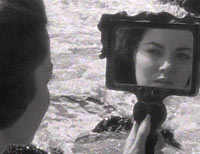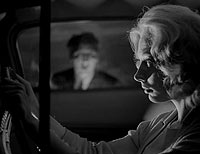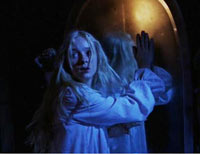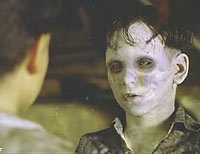Five Horror Movies For People Who Don’t Like Horror Movies
Published on September 29th, 2010 in: Halloween, Horror, Listicles, Movies, Staff Picks, Top Five Lists |The autumnal season is upon us, and with it, the onslaught of Halloween in all its grease-painted, fun-sized glory. This is great news for the gorehounds and horror-movie fanatics . . . but what of us petite flowers who faint at the sight of blood? You, my friends, are in luck! Herewith are five feature films that eschew the viscera in favor of suspense and chills.

Cat People (Jacques Tourneur, 1944)
In the mid-1940s, producer Val Lewton turned the struggling RKO Studios around with a series of cerebral, low-budget horror movies that met with great critical and popular acclaim. The first of these was Cat People, an engaging feature that revolutionized how horror movies were made.
The film follows the troubled relationship of Irene Dubrovna (French cinema legend Simone Simon) and Oliver Reed (Kent Smith). After a whirlwind courtship, the pair wed. Due to Irene’s fear that she will turn into a panther and kill her lovers when brought to ecstasy, the couple are unable to consummate their marriage. As Oliver begins a flirtation with his comely, fast-talking coworker Alice (Jane Randolph), however, Irene’s feline side begins emerging.
Due to the low budget ($150,000) and fast turnaround time (18 days), Lewton and Tourneur were unable to match their fellow studios’ monster-fests. Instead, they grounded the horror and suspense of the story and conflict in something resembling real life. (The protagonists live in a city not unlike New York and work as a fashion illustrator and an architect, unlike Transylvania-bound Dracula and the Wolf Man.) They also addressed marital conflict and brought in psychological analysis, both explicitly and implicitly. When Irene expresses her concerns about unleashing her inner panther while making love to her husband, Oliver takes her to see Dr. Louis Judd (Lewton regular Tom Conway, who would reprise his role in Curse of the Cat People and The Seventh Victim).
On a more implicit level, Lewton and Tourneur played with the psychology of the film by relying on suspense instead of obvious scares. The most palpable way in which they did this was via a scene in which Irene stalks Alice through Central Park. Through unbearably long shots, stark lighting, and sound design, the pair created a sense of suspense by making the audience think Irene would turn into a panther and maul Alice at any moment. The hissing of a bus as it pulled up to the curb both shocked the audience and came as a relief that Alice would not die. This effect later became known as “the bus.”

Night Tide (Curtis Harrington, 1961)
Throughout the 1960s and ’70s, Curtis Harrington was an unsung hero of low-budget horror features, many of which harkened back to cinema’s Golden Age. His first feature, Night Tide, contrasted with his later works in the naturalistic approach to its mythic subject matter.
The late Dennis Hopper plays Johnny Drake, a sailor on shore leave who falls in love with a mysterious beauty named Mora (Linda Lawson). Through her work portraying a mermaid in a sideshow on the San Pedro boardwalk, Mora has come to believe that she is a Siren and is luring men to their deaths. Johnny can’t believe that his inamorata would be capable of such actions, until a fateful night under the full moon.
Like Lewton before him, Harrington grounds his action in real life by shooting on location in San Pedro and coaxing realistic performances from his lead actors. (I’ve never seen Dennis Hopper quite so endearing in any other film.) He also folds in some deliberate high camp, as Johnny visits an all-male massage parlor. The noir-ish lighting and violent storms of the film’s second and third acts create a palpable sense of terror.

Carnival of Souls (Herk Harvey, 1962)
One year after Harrington’s maiden feature, commercial and industrial film director Herk Harvey made his lone narrative film. Church organist Mary Henry (played by scream lady-in-waiting and future novelist Candace Hilligoss) takes a job away from home (as a church organist) after surviving a car accident. In the weeks following the wreck, a mysterious, chalk-faced man (Herk Harvey himself) beckons Mary to enter the abandoned Saltair Pavilion and dance with other abandoned souls.
In the audio commentary for the Criterion Carnival of Souls, Harvey’s collaborator John Clifford cites Bergman and Cocteau as influences on the film. While the contrast-heavy black and white cinematography, the slow editing, and the organ music lend the film an eerie, arty feel, at times it takes on the tone of a really good feature-length episode of The Twilight Zone. (Fans of Rod Serling’s deathless series may recognize the film’s plot as the episode “The Hitch-Hiker.”) While some aspects of the film may seem a bit broad to today’s audiences (most notably Mary’s neighbor’s creepy, ham-handed attempts at flirtation), the montage at the abandoned Saltair and the final moments of the film will send a shiver down the spine.

Lemora: A Child’s Tale of the Supernatural (Richard Blackburn, 1973)
How’s this for a horror movie pedigree? Lemora: A Child’s Tale of the Supernatural was the sole directorial feature by Renaissance man Richard Blackburn, who’d go on to co-write Eating Raoul and direct episodes of Tales from the Darkside. It was inspired by “art” films such as Night of the Hunter (which, at the time of Lemora‘s release, had yet to be re-evaluated by film critics and historians) and by the directorial works of Cocteau. At the time of its release, the film was censured by the Catholic Church, and would later go on to an extensive afterlife as a favorite on “creature feature” TV shows in the ’70s and ’80s.
In the audio commentary for the restored Lemora, director Blackburn acknowledges that he didn’t know he wasn’t supposed to make an ornate period horror as his first and only feature, or to reveal the film’s protagonist in the middle of the third reel. In many ways, the artistic chances he takes make this film memorable. The feature depicts Lila Lee (grindhouse legend Cheryl Rainbeaux Smith), an innocent, church-going girl who wishes to save her father from imminent danger in another town. Little does she know that the vampire Lemora (Lesley Gilb, in an elegant, passive performance) has lured her to her isolated home in the country to serve as the vampire queen.
What the film lacks in budget, and at times in credible performances, it makes up for in production quality and atmosphere. Every penny of Lemora’s budget is onscreen in the gorgeous cinematography and production and costume design. The lurid blue-based colors Blackburn and DP Robert Caramico employ in the scenes in Lemora’s home give the film a glossy look similar to that of 1950s pulp paperbacks. At the center of the film is Cheryl Rainbeaux Smith, an underrated actress who made her name in B-pictures and drive-in movies of the 1970s. She plays the role with a palpable innocence and great melancholy, amplifying the shock and surprise of the film’s closing scenes.

The Devil’s Backbone (Guillermo del Toro, 2001)
In a contemporary horror landscape deluged with torture porn and the kind of shocking body horror that would give David Cronenberg the vapors, Guillermo del Toro’s features come to thoughtful viewers like a breath of fresh air. While del Toro has never shied from gore, his work has a cerebral, myth-rooted bent that engages audiences instead of trying to shock the bougies. Almost any of the eight features he directed could take up this space, but for the purposes of this article I selected the first feature I’d seen by del Toro, and the one that made me a devotee of his directorial work.
The time is the tail end of the 1930s, as the Spanish Civil War draws to a close. The place: a run-down boys’ orphanage on the Spanish countryside. The new boy, Carlos (played by the eerily subtle Fernando Tielve), begins to pick up on a sinister force in the school. It could come from the administration’s support for the failing revolutionary party, or the creepy caretaker Jacinto, or the hazing Carlos receives at the hands of the orphanage bully . . . but something doesn’t feel right for him. One night, a disheveled young boy named Santi (Junio Valverde) visits Carlos at night and gives him the cryptic message that “Many of you will die.” What follows is a chilling quest that brings to mind Night of the Hunter.
Del Toro creates a suspenseful atmosphere for the audience with his use of slow editing and a sparse, earth-toned palette. His use of historical facts and mythic symbolism position the dawning horror of the boys’ home in a recognizable reality. Further, he draws fantastic performances from his child actors, whose subtlety and intelligence make the film seem much truer.
“Met State” (Bryan Papciak, 2001)
For my bonus selection, I’ve chosen a personal favorite: a short film. Throughout the late 1990s, animators/urban explorers Bryan Papciak and Jeff Sias made many visits to the now-abandoned Metropolitan State hospital that served New England’s mentally ill community through much of the 20th century. They began taking 16mm cameras with them, with the intention of making a short film.
The ten-minute short subject they completed, “Met State,” is a symphony of pixilation, stop motion animation, and creepy observation scored to Saint-Saens’ “Danse Macabre.” While the film had a long history on the fest circuit (where it won the Best Cinematography award at Sundance in 2002), it’s only recently cropped up online at Vimeo. Watch it here.
3 Responses to “Five Horror Movies For People Who Don’t Like Horror Movies”
October 5th, 2010 at 1:32 pm
“Don’t Look Now” could probably be added to this list, too.
October 5th, 2010 at 6:28 pm
Ha! I think the scariest part is the sex scene with FOOT IN THE FACE.
LLM
October 11th, 2010 at 10:23 pm
I’ll have to check out The Devil’s Backbone – thanks for the heads up!
Time limit is exhausted. Please reload the CAPTCHA.